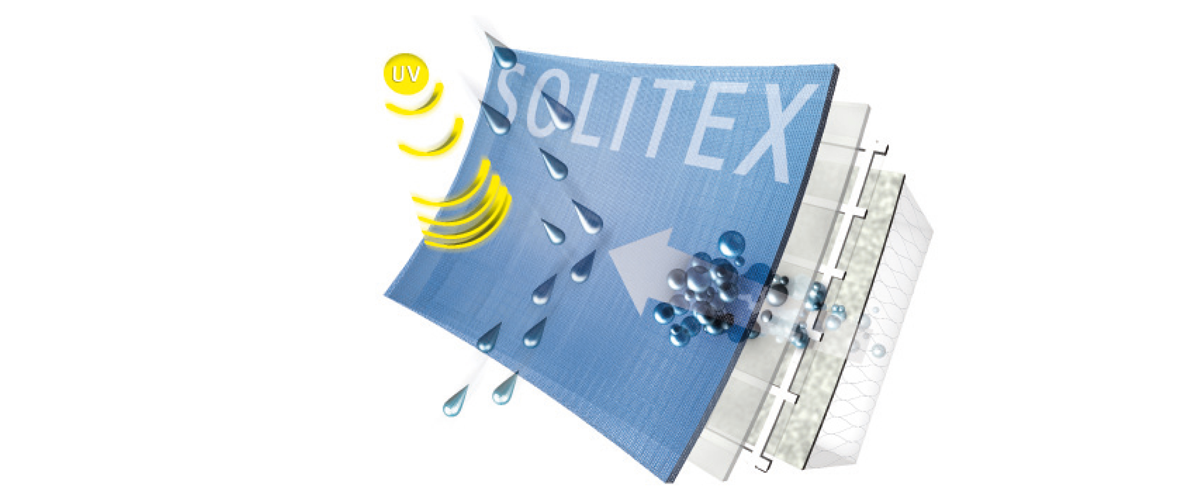SOLITEX MENTO - actively vapour open, airtight and waterproof
Pro Clima has extensively tested all their products to the German requirements. But since we are in using these materials for high performance construction in the USA, not Germany, we had the SOLITEX MENTO membrane tested for compliance with the Accepted Criteria 38 as defined by the ICC-Evaluation services. As expected the membrane surpassed all testing thresholds with large margins.
Air Permeance (ASTM E2178)
A 1.2x1.2m (4x4ft) membrane is conditioned at 68.8F and 40% RH for 7 days. It is clamped in the test apparatus with gaskets, after which a series of test pressures are applied to the membrane (25,50,75,100,150 and 300 Pa). Leakage at 75Pa has to be below 0.004 cfm/ft2 to conform to AC38 - for SOLITEX MENTO the leakage was 0.00004cfm/ft2 - a factor 100 tighter than the threshold.
Water vapour Permeance (ASTM E96 - method B - wet cup)
This test is to determine how vapour open a material is in relatively humid conditions. In the B (water method) a 2.7" diameter cup is air-tightly covered with the membrane. The cup is filled with water. The surrounding air is 75F and 50% relative humidity. The cup is periodically weighed over the test period of 264 hours. This weight is then plotted as a function of time. Water vapour transmission is taken as the slope of the curve (in the linear region) divided by the area of the dish opening. The result is the perm rating of the material at the set conditions.

Vented roof with SOLITEX MENTO 1000 (BLDGTYP.blogspot.com)
In this test setup the air below the membrane has a much higher RH, which results in avapour drive out through the membrane. The result of the 3 test conducted with SOLITEX MENTO was a Permeance of 38 (7.8x10-3 g/m2-hr-Pa). The European test (ISO 12572) uses a much different set of testing criteria and results in an Sd-value of 0.05m, which converts into a perm rating of 66.
In both cases the perm rating is sufficient to make an assembly that is 5 times more open on the exterior than on the interior in cold conditions (see this blogpost about this outward drying rule of thumb). And the most important material property of the SOLITEX MENTO membrane is the active drying capacity it has. The TEEE membrane keeps on transporting vapour outwards even in the most challenging conditions, when conventional perforated WRB-s stop performing (see this blogpost).
Water resistance (AATCC 127 per AC38)
In the AATCC (American Association of Textile Chemists and Colorists) 127 test, a 200x200mm specimen is put in a test apparatus which placed a head (pressure) of water onto the membrane. In the AC38 method, the membrane is exposed to 55cm (22") of water column for 5 hours. It passes when there is no leakage - of course SOLITEX MENTO being a monolithic membrane passed this test easily.
AATCC127 method matches ISO 881 - in which the water pressure is raised 10mm/s - it is then determined how much water-column will lead to water leaking through the membrane. SOLITEX MENTO 1000 in that test has resistance to 10m.
Both test results indicate the very waterproof properties of this Pro Clima membrane.

SOLITEX MENTO - long lasting membrane that keeps the elements out
UV-exposure & Accelerated aging
3 specimens are exposed to UV light for 10 hours a day for 21 days. After the test the specimens will pass if there is no peeling, chipping, cracking, flaking, pitting or other damage.
3 specimens that were already exposed to the UV test, are now exposed to 25 cycles of 3 hours at 120F, immersion in water at room temperature for 3 hours, which is then air dried at 73F for 18hrs. Again the specimens are checked for damages. SOLITEX MENTO passed both test without any noted damages.
Flame spread and Smoke development index
ASTM E84 test was performed to establish the flame spread and smoke development index (SDI) of a material. One end of a 18" wide, 24' long section is suspended on the ceiling of a fire box. It is exposed for 10 minutes to a flame. The results are bench marked against mineral fiber cement board (which is valued at 0 for both) and oak decking. The oak calibrates the tunnel if the flamespread reaches the end of the tunnel afte 5 minutes and 30 seconds and has a SDI of 100.
SOLITEX MENTO tested with a flame spread of 0 and and SDI of 85. Which qualifies it as a Class A material - and thus conforms to use as WRB in non-combustible construction according to AC38 and the IBC section 803.1.1



